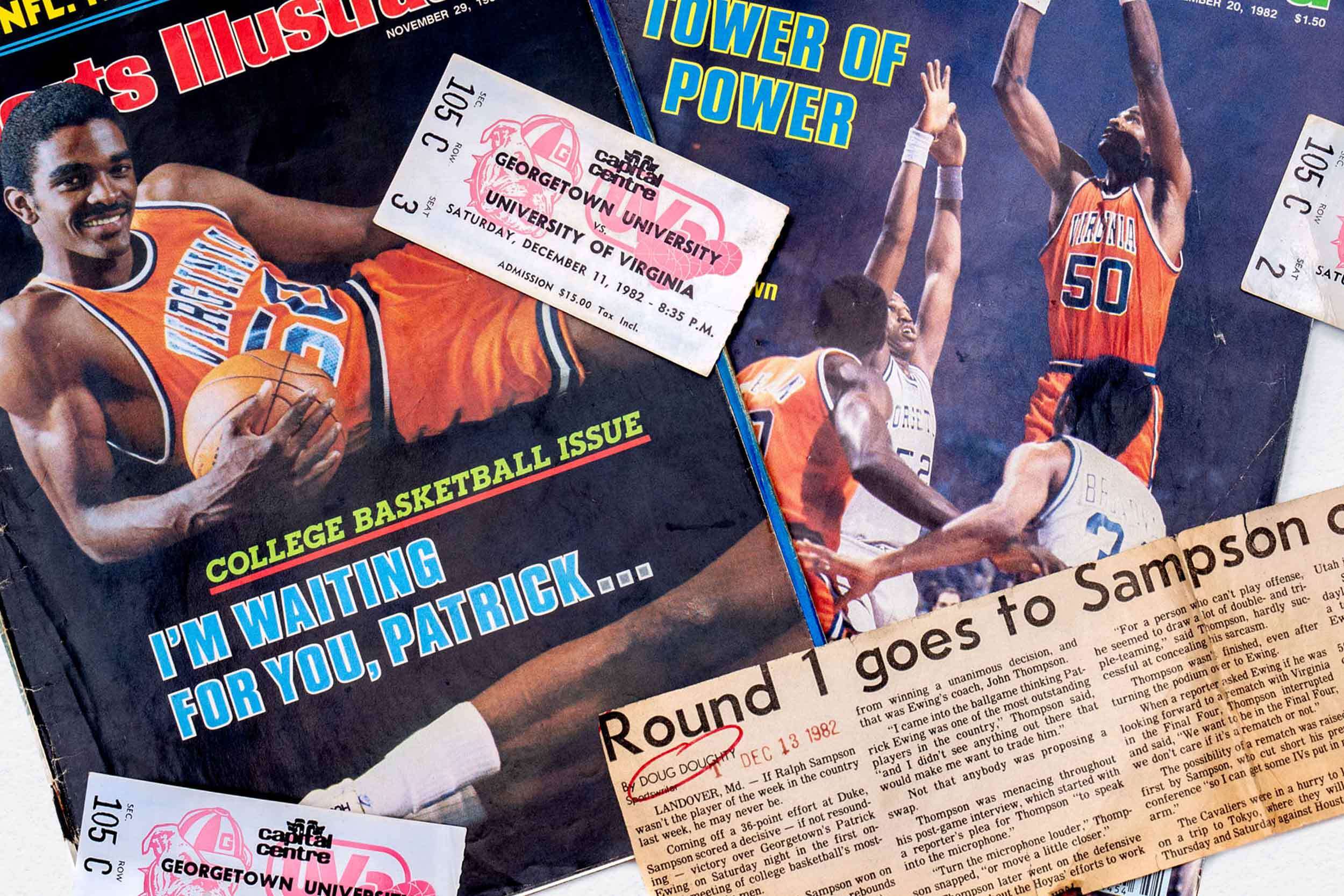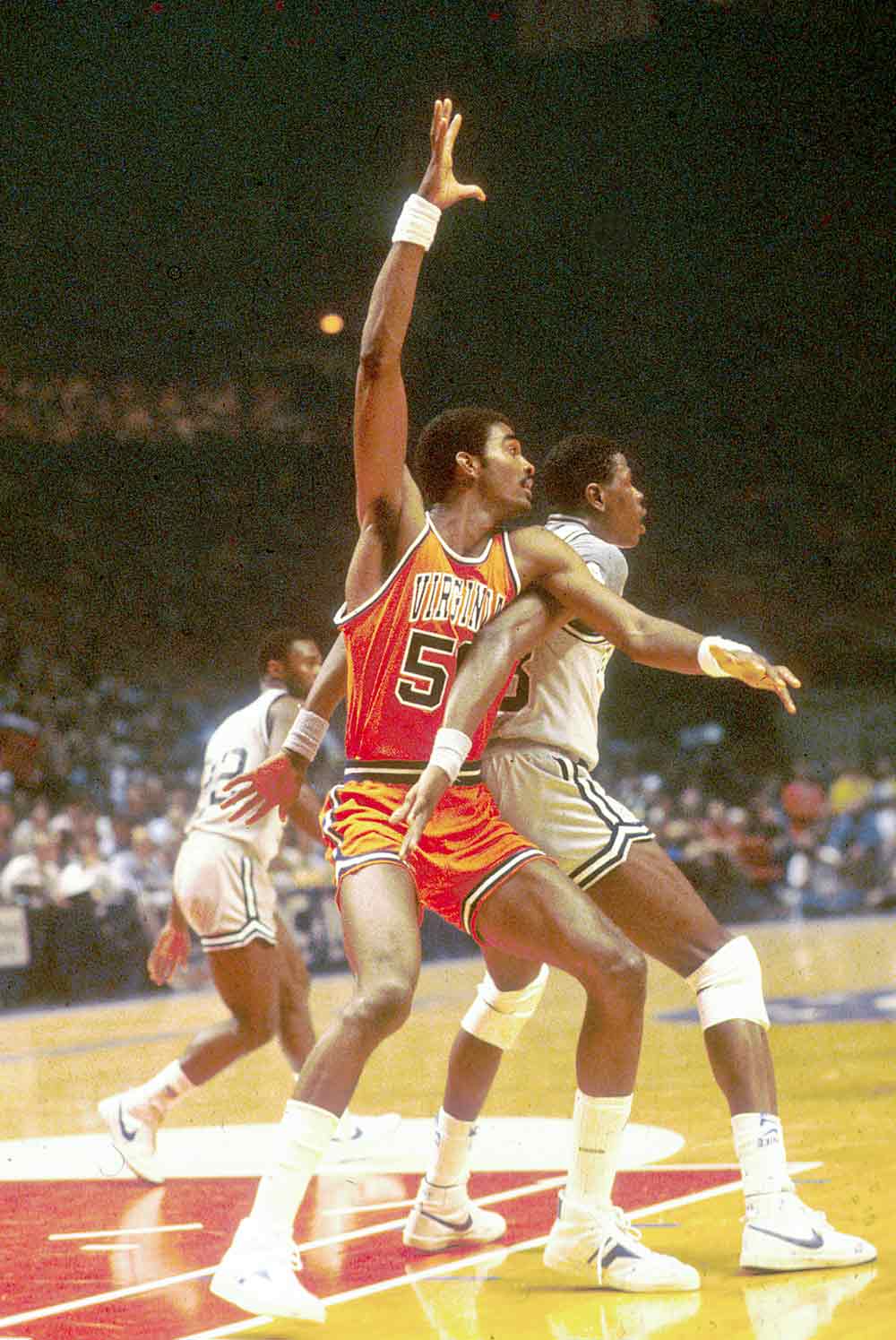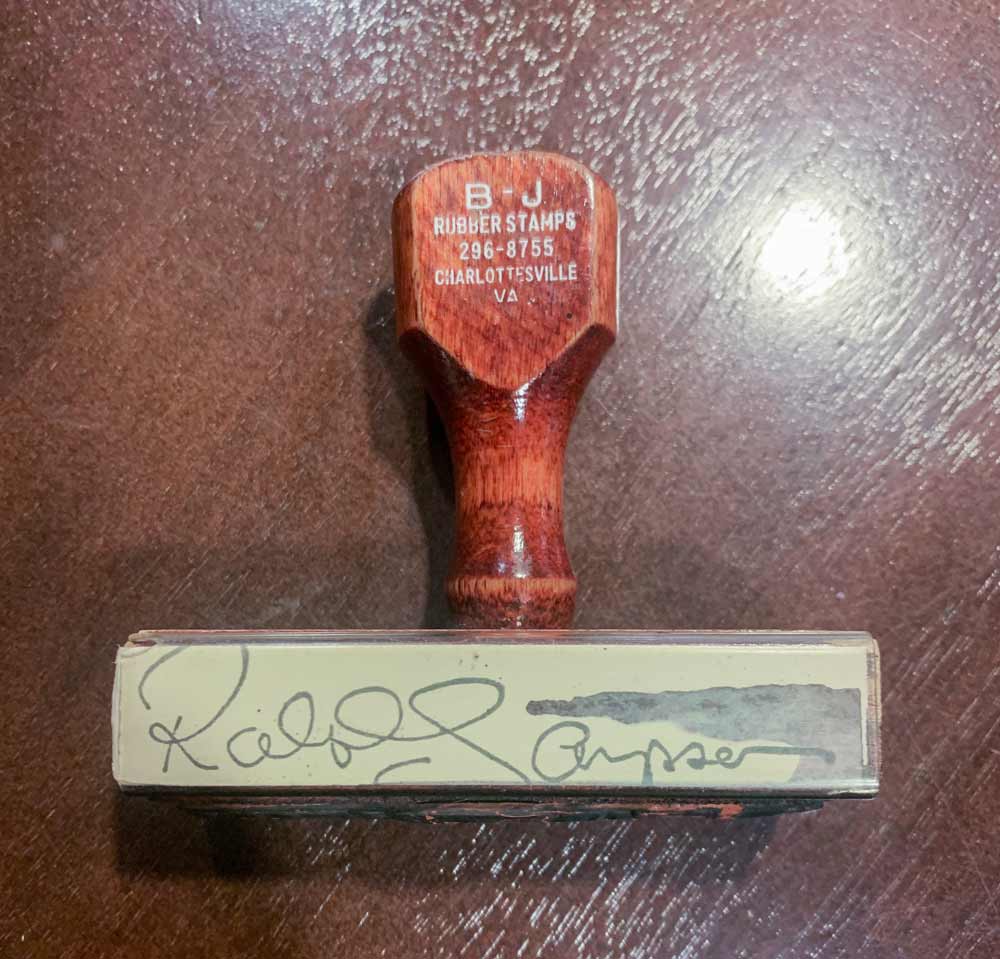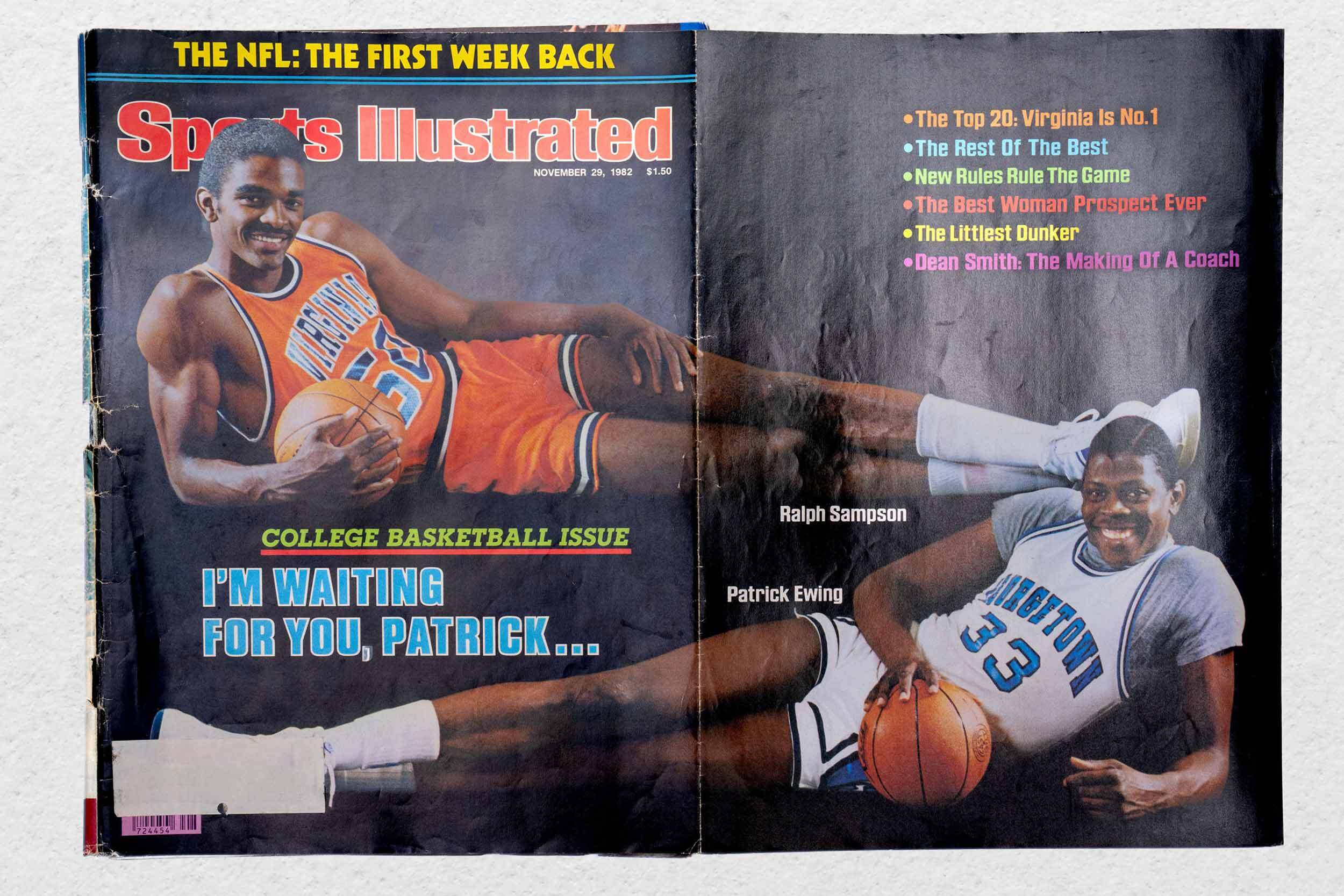
Coverage of Virginia’s game against Georgetown reached unprecedented levels. (Photo by Sanjay Suchak, University Communications)
Official records from the University of Virginia’s men’s basketball clash with Georgetown University on Dec. 11, 1982 say 19,035 fans crammed into the Capital Centre to watch what many media outlets had dubbed “The Game of the Decade.”
Four decades later, Jimmy Miller, a sophomore forward on that UVA team, argues that attendance number might be off by at least one.
“I felt like I was a spectator in that game,” Miller said. “At one point, I was ready to get up and applaud.”
It’s been 40 years since Miller, who actually played for 16 of the game’s 40 minutes, felt like a bystander that night in the Landover, Maryland venue (which was demolished in 2002). He wasn’t alone.
“If you were to look back,” former Cavalier guard Othell Wilson said, “you’ll see a lot of us standing there watching.”
Miller and Wilson, just like the 19,000 in the stands and the millions across the country watching their television screens, were focused on two large and gifted men: Georgetown’s Patrick Ewing and Virginia’s Ralph Sampson.
One had led his team to the national championship game nine months earlier. The other was soon to be named the best player in college basketball for a third straight season. Both stood over 7 feet tall. Both were on the verge of becoming top picks in the National Basketball Association draft. Both are now members of the Naismith Memorial Basketball Hall of Fame.
Back then, the matchup was being compared to a legendary heavyweight title boxing match.
“Felt like (Muhammad) Ali-(Joe) Frazier,” said Doug Elgin, UVA’s sports information director from 1980 to 1983.
In modern times, you might only anticipate this kind of duel prior to tuning into HBO on Sunday nights.
“You know in ‘Games of Thrones,’ when the two sides are battling, and each side has the unique giant creature?” former UVA forward Tim Mullen said of the popular fantasy television drama. “This was kind of like that. Just two people that were physically in a different space than everyone else on the court.”
It would sound like a myth, if it didn’t really happen.

This image from the game – with Ralph Sampson battling for position against Patrick Ewing – is displayed on the concourse level at John Paul Jones Arena. (Photo by Dan Grogan)
The story of No. 1-ranked Virginia’s 68-63 win over No. 3 Georgetown in December 1982 is much more than a final score. It was a big-money television deal, months of unprecedented hype, a peculiar photoshoot, an electrified arena and a sequence for the ages.
“Ralph and Patrick,” former Cavaliers guard Ricky Stokes said, “they were everything as advertised.”
The following is a reliving of that epic event – and the extraordinary hoopla that surrounded it – told through the recollections of those who remember it best. Their titles represent their status on Dec. 11, 1982.
Dueling Legacies
Long before they faced off, Ralph Sampson and Patrick Ewing were highly sought-after recruits who more than lived up to expectations in college. Sampson’s combination of talent – by December 1982, the senior had already been named National Player of the Year twice by The Associated Press – and size – a rarely seen 7-foot-4 – naturally made him a literal Big Man on and off Grounds.
Jimmy Miller, UVA sophomore forward: Ralph is why I ended up choosing to come to Virginia. The academics, the school, Coach Terry Holland, all those things checked off boxes for me, but they had this phenom. No other person on the planet was like him at the time.
Tim Mullen, UVA sophomore forward: No matter where you were with him, it was a spectacle.
Ricky Stokes, UVA junior guard: It was every day, every meal, every bus ride, every game. We went to Japan and Ralph went to the restroom and there were 100 reporters there.
Othell Wilson, UVA junior guard: Even the people who didn’t know who he was, just because of his size, they were fascinated with him.
On the road, we had to do things a little bit different than normal teams because of Ralph. We wouldn’t walk right through a hotel lobby or anything. We would have to have special instructions to go underneath or go the back way.
Dave Odom, UVA assistant coach: I remember being out on a Sunday night with the team. We’re in this very nice steakhouse in Charlottesville and everybody’s eating and here comes a couple of parents with their kids. And they walk right up to Ralph as if they owned the place and said, “Ralph, can I have your autograph? Can I have your autograph?”
Kim Record, student assistant in UVA sports information office: One of my responsibilities was to read Ralph’s fan mail – he got a lot – and sort of respond. We had a rubber stamp of his signature that we would use on photos we’d send back.
There were lots of letters from young kids – “I want to be like you” – and there were letters requesting, you know, wanting to go out with him.

Sampson’s popularity was so immense that the UVA athletics department had to create a rubber stamp of his signature to use in replying to fan mail. (Photo by Paolo Fridman, UVA Athletics)
While Sampson had established himself as college basketball’s premier big man, Ewing, as the Roanoke Times noted, was quickly becoming Sampson’s “heir apparent.” The 7-foot Ewing had a scintillating freshman season in 1981-82, earning a trophy case full of honors, including the Big East Conference’s Rookie of the Year and Defensive Player of the Year awards. Though the Hoyas fell in the 1982 national championship game to Michael Jordan and the University of North Carolina, Ewing made a statement with a 23-point, 11-rebound, three-steal, two-block performance.
Jim Marchiony, Georgetown sports information director: The hype on Patrick started when he announced he was going to Georgetown – and it didn’t stop.
Prior to Ewing’s arrival, Georgetown played its home games at the on-campus McDonough Gymnasium with a capacity of around 4,000. That changed in 1981.
Marchiony: The demand for tickets was just so great that we had to move the games to the Cap Centre.
Though it was a 40-minute drive from Georgetown’s campus in Washington, D.C., the Capital Centre was home to the NBA’s Washington Bullets and the National Hockey League’s Washington Capitals and had considerably more room to host those wanting to get a glimpse at Ewing and his imposing 6-foot-10 coach, John Thompson.
Jim Larrañaga, UVA assistant coach: There’s no question that Georgetown had this mystique about them. And I think John Thompson used the phrase, “Us against the world.” And they built a wall around that and built strength within that wall to prepare for any battle or any war that they were going to wage.
Marchiony: John had a rule that freshmen weren’t allowed to be interviewed until the second semester of their freshman year. So that kind of added to the aura of the whole thing.
Mullen: To a lot of people, Patrick Ewing was one of the scariest players in the country. But he was my mom’s favorite non-UVA college player. She thought he had the sweetest smile.
Despite spending three weeks in February ranked No. 1 in the country, UVA’s 1981-82 season ended in the regional semifinal round of the NCAA Tournament with a loss to the University of Alabama-Birmingham. Sampson, for a third straight year, was projected to be the top pick of the NBA Draft. He again had a decision to make on whether he’d return to school or go pro.
Doug Elgin, UVA sports information director: I handled media relations for the football team in fall, the men’s basketball team in the winter – and then Ralph Sampson in the spring, which was a circus. The most difficult thing was to manage the media with the intention of whether Ralph would come back. In the spring, that really was a full-time focus for me.
Ralph Sampson, UVA senior center: I loved my teammates, I was on course to graduate at that time, I loved the University of Virginia as much as anyone ever had. I had great coaches – Coach Holland, Coach Larrañaga, Coach Odom – so I was enjoying what I was doing. Those were all things to stay.
Obviously, that Georgetown game was eventually put on the schedule, but that wouldn’t have made a difference for me at that point. If I was ready to come out and wanted to do it, I would have.
Despite being separated by fewer than 120 miles, Virginia and Georgetown had only played each other four times. A final chance to pit Sampson against Ewing was a made-for-television moment captured by game promoter – and future Virginia politician – Russ Potts. Potts, who ran Sports Productions Inc., invited bids from seven networks and syndicators. Turner Broadcasting System won, paying $575,000 for rights to the game. Sports Illustrated called it “the most important sports event ever to appear on ‘basic’ cable TV.”
Marchiony: There were very few college basketball games shown nationally at that time. This game – not only was it hyped because it was Ewing and Sampson, but it was one of the few games all year that was shown nationally, even those in the NCAA Tournament.
ESPN had just started in September in 1979 and wasn’t in a ton of homes back then. And relatively few people had cable back then. So for TBS to show the game, it meant that they felt they could make it worth their while financially.
In the summer of 1982, Marchiony hosted a news conference to announce the game. The speakers included athletics directors from both schools, Potts and TBS president Robert Wussler. A framed photo of the event still sits in Marchiony’s home office.
Marchiony: That just added to the mystique to the game. Because no one had a press conference to announce a regular-season game.
The Photoshoot
Media buzz only took off from there, climaxing with the Nov. 29, 1982, edition of Sports Illustrated. The magazine’s college basketball preview issue was loaded with Sampson-Ewing coverage. Curry Kirkpatrick wrote an eight-page feature story on the matchup that was accompanied by six illustrations of the two centers battling each other and a sidebar story on TBS’ role in the making of the game.
It's the magazine’s cover, however, that remains iconic. Sampson, on the top level of the cover, and Ewing, on the bottom, are lying on their sides. Ewing’s face is only seen once the cover pulls out to reveal another page. “I’m waiting for you, Patrick ...” reads the headline.
Elgin: SI wanted to get Patrick and Ralph together for the cover photo, but Terry Holland wasn’t about to take Ralph to D.C. for it, nor was John Thompson willing to bring Patrick to Charlottesville. And we talked about meeting in a little town in between, but it would have been too difficult.
So, SI decided to shoot them separately and have a fold-out cover. It was a very creative way to do that knowing you couldn’t get the two of them together for a photoshoot.
Sampson’s shoot was done in an event room at the Cavalier Inn. Elgin invited Dan Grogan, an independent photographer living in Charlottesville, to assist Sports Illustrated photographer Ronald C. Modra. Elgin figured Grogan, a 1975 UVA graduate who had photographed Sampson numerous times for various outlets, could help break any tension in the room and make the shoot run smoothly.
Elgin: Ralph trusted Dan.
Dan Grogan, independent photographer: Ralph could be reticent with these things. He was not very cooperative when he got to this shoot room and there was this big roll of seamless paper behind him.
Sampson: I wanted to get out of the photoshoot and get into practice. Get my weights in, get my schedule done. You’re messing with my schedule to play, so just tell me where to be. I did what I had to do and got out.
Grogan: I started making some gestures behind (Modra) to loosen Ralph up. I didn’t want to interrupt the shoot, but I knew what Ralph could be like when he was in a mood.
Elgin: Dan Grogan is the only reason Ralph was smiling.
Grogan: The photographer’s going, “Oh Ralph, that’s it! Ralph, work with me – that’s it!” And Ralph was starting to laugh.
Sampson: I didn’t know what their concept was. Like, “OK, you’re going to put us down side-by-side? How’s that going to work on the cover?” And it ended up working better for me because I was on the front and Patrick had the fold-out.
Curry Kirkpatrick, Sports Illustrated college basketball writer: At Sports Illustrated, I doubt we ever did a fold-out cover for college basketball besides that one. We very rarely ever did a double cover for anything.
Between the pre-game and post-game coverage – which featured Sampson on the cover of the Dec. 20, 1982, issue – Sports Illustrated dedicated a combined 16 magazine pages to Virginia-Georgetown.
Kirkpatrick: At SI, that much space was really only reserved for Super Bowls and World Series. This was truly unheard-of for a college basketball game. That tells you how epic this thing was, and how big those two guys were.

The Game ... Finally
While all the hype would make you think otherwise, the Virginia-Georgetown showdown was NOT the season opener in 1982-83. The top-ranked Cavaliers had five games to play before their trip to the Capital Centre. The Hoyas, ranked second in the preseason poll, had six.
Wilson: Our coaching staff kept things routine. They didn’t talk about the Georgetown game; they didn’t talk about anything about that until it came up on the schedule.
Larrañaga: Coach Holland was so good at taking games one at a time. He did not emphasize Georgetown. He emphasized the next game. Who was our opponent? How do we get ready to play well against them? How do we build our confidence?
UVA’s precursor to Georgetown was a Dec. 8 stop at Duke University. Kirkpatrick’s story claimed that Duke’s famed Cameron Crazies student section peppered the Cavaliers with chants of “Georgetown! Georgetown! Georgetown!” UVA won the game, 104-91, to remain undefeated. The Hoyas did their part, too, sweeping their first six opponents. The only close call was a 70-66 overtime win over Western Kentucky University on Dec. 4.
Elgin: Georgetown was playing Western Kentucky right before our game and I was at a get-together at Terry Holland’s house with some coaches and others in the Virginia community. We were rooting like hell for Georgetown because a battle of the unbeatens would have been more front and center than had they lost in that game.
Ann Holland, Terry Holland’s wife: In those days, I didn’t have things catered. I cooked everything for everybody. That night, I was trying to get food and snacks and stuff so that everybody would have something, and there was just this tenseness. It wasn’t like the regular get-togethers we would have at the house.
I remember thinking, “What’s wrong with everybody?”
With Georgetown serving as the home team – though each school was allotted 9,000 tickets – Marchiony was in charge of handling media credentials for the Virginia game.
Marchiony: We got around 300 requests. I don’t know how many we ended up giving out, but press row, which was the length of the court, was full, as was the hockey press box. And there were some people in the press room. In fact, some of the people in the hockey press box went into the press room and watched it on TV because you could see it better.
The most suspicious request came from a radio station that wanted a seat for a photographer.

